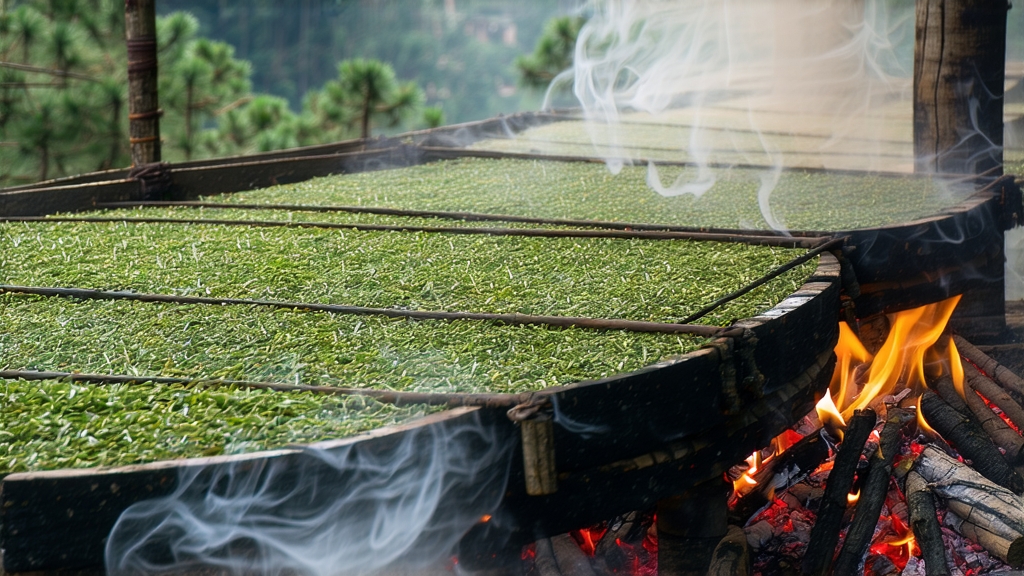
Ask most Western drinkers to name a Chinese black tea and they will murmur “Earl Grey” or “English Breakfast,” unaware that both blends were originally built around a single leaf born in the granite gorges of northern Fujian. That leaf is Lapsang Souchong—Chinese name Zheng Shan Xiao Zhong—the world’s first fully oxidised tea and the prototype for every black tea that followed. Its story begins in the Wuyi Mountains during the late Ming dynasty, when a passing army forced farmers to speed-dry freshly picked leaves over open pine fires so that the crop would not spoil. The accidental smoke infusion created a liquor so deep, sweet and resinous that Dutch traders carried it to Europe in 1604, igniting a fashion that would reshape global commerce and, ultimately, spark the Boston Tea Party. From those serendipitous embers, Lapsang Souchong has split into two distinct families: the traditional pine-smoked original, still produced within the 60 km² core of Tong Mu Guan village, and the modern unsmoked “zheng shan xiao zhong” crafted for the contemporary Chinese palate, which highlights cocoa, longan and honey notes without the campfire aroma. Both styles share the same cultivar—Xiao Ye Zhong, a small-leaf camellia sinensis var. sinensis that has adapted to the mineral-rich, mist-shrouded terraces of the Wuyi UNESCO site. Spring picking begins when the mountain air is still cool enough to preserve the leaf’s volatile aromatics; only the tender one bud, two leaf standard is plucked, never after the Qingming festival when rising temperatures coarsen the sap. Once picked, the leaves wither on bamboo trays inside a three-hundred-year-old wooden loft whose shutters are opened or closed to regulate the mountain breeze. When the leaves feel as supple as kid leather they are rolled, not by machine but by fist: a 12-minute rhythmic pressing that ruptures cell walls and releases the enzymes that will drive oxidation. The rolled leaf is then nestled into deep rattan baskets and left to ferment for four hours in a pine-panelled room kept at 24 °C and 75 % humidity. Here the magic of colour change occurs: emerald slowly bruises to copper, then to the dark chocolate brown that Chinese traders once called “red” because the liquor, not the leaf, glows vermilion in the cup. For traditional Lapsang, the final act is smoking. The oxidised leaf is spread on sieves stacked inside a brick kiln where fresh pinus massoniana and local Chinese red pine are burned without flame; their resinous smoke curls upward for eight hours, drying the tea and gifting it the signature tarry sweetness that Europeans once likened to single-malt whisky. The unsmoked version skips the kiln and is instead baked at 80 °C over charcoal made from local oak, yielding a cleaner, fruit-forward profile that dominates today’s domestic market. Regardless of style, finished tea must rest for thirty days so that residual smoke or bake notes can marry with the leaf’s innate sugars, a process known as “returning to flavour.”
Brewing Lapsang Souchong demands restraint; its layers unfold only when treated with the delicacy normally reserved for green tea. Use 3 g of leaf for every 120 ml of water, ideally drawn from a spring or low-mineral source. Heat the water to 90 °C—just below a rolling boil—because hotter temperatures will drag the tannins forward and mute the subtle malty sweetness. Rinse the leaves for three seconds to awaken them, then steep the first infusion for ten seconds, increasing each subsequent steep by five. A gaiwan or small Yixing teapot is preferable; the narrow aperture traps aroma, allowing the drinker to savour the evolving spectrum of pine resin, dried longan, cocoa and, in older vintages, a whisper of menthol. A high-grade Lapsang will yield six infusions, the third usually being the most balanced, after which the smoke recedes and the honeyed mineral core dominates. If you prefer Western service, steep 2.5 g per 250 ml for three minutes at 95 °C, but expect a brasher cup; the Chinese method is closer to a meditation, the Western to a campfire breakfast.
Tasting begins with the dry leaf: rub a few strands between your palms and inhale—premium smoked versions will exhale a clean pine note